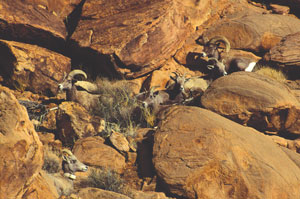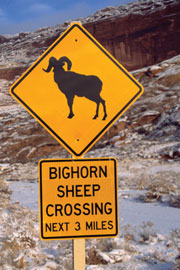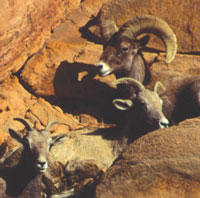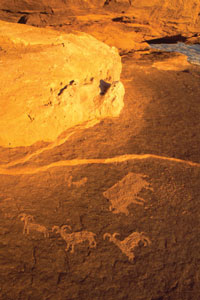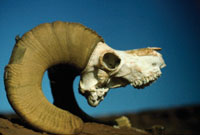Ancient petroglyphs created by Ancestral Puebloans that roamed southern Utah long ago often depict the wild sheep of the Canyon Country: the desert bighorn. Square-bodied animals with backward curving horns adorn many rock art panels and indicate the importance of this species to the Native Americans. Although these prehistoric people hunted mule deer and elk, you just don’t see that many glyphs of these animals.
The male bighorn sheep’s massive C-shaped horns provide the common name for these creatures. Both sexes have horns, although the female’s horns are smaller and about the size of a yearling male’s horns. At a distance, females may be difficult to distinguish from the young males.
Unlike antlers which are shed each year, the desert sheep’s horns are permanent. A sheath of keratin, the same stuff that makes our fingernails, covers a bony core honey-combed with air chambers to reduce the overall weight of the horn. The horns put on a growth ring each season that temporarily halts during the rut or breeding season. Like a tree’s growth ring, biologists count the number of growth rings on the horns to determine the sheep’s age.
As the older rams establish their hierarchy, the importance of these massive horns comes into play. If body language and posturing don’t settle the dominance question between two males, they engage in the classic activity of head banging to determine who is top dog.
Seeing two animals back up a few steps then charge each other is truly a spectacular sight. The males rise up then lower their heads just before contact. The collision sounds like a rifle shot and may be heard several miles away. Powerful necks and cushioning in the skull absorb much of the impact; still, it looks like that’s gotta hurt. (Kids don’t try this at home!) To the victor goes dominance over other males and the opportunity to mate with females in the group.
During the breeding season (November and December), the generally loner males congregate with groups of females, yearling males and lambs from the current year. A lot of posturing, lip curling, smelling, chasing, and body butting takes place at this time. Some groups may contain a bunch of animals and these provide a great opportunity to see different age classes at one time. And because the individuals are intent on the time of year, they may be less likely to spook and run off like they do during other parts of the year.
The Utah Division of Wildlife Resources manages desert bighorn populations with periodic transplants from healthy herds. Back in the 1980’s when I worked at Arches National Park, one such relocation occurred involving bighorns from Canyonlands National Park that were captured and moved to Arches. This group made up the initial reestablishment of sheep in Arches, since the population had crashed years before. Interestingly, some of the transplanted sheep took to foraging along the highway near the park entrance. Whether these are the same sheep today or they’ve taught their offspring, you might still see desert bighorns right from Highway 191 between the Colorado River Bridge and the Arches National Park entrance. Certainly not the norm for these rugged terrain-loving animals. But even if you miss the live ones, check out the rock art panels along the Potash Road or near the trailhead to Delicate Arch to get an idea about these November head-bangers.
To learn more about these magnificent creatures and their current population status, the Utah Division of Wildlife Resources will host the Desert Bighorn Festival in Moab, November 20-21, 2009. A presentation at the Moab Information Center at 7:00 p.m. on November 20 will cover the life history of these wild sheep. The next day will be a field trip to view desert bighorns in action. Remember to bring appropriate clothing, snacks, binoculars, spotting scopes, and cameras. Carpooling minimizes any disturbance, and details about the field trip will be discussed at the lecture. For more information visit the UDWR website at http://wildlife.utah.gov/calendars.
